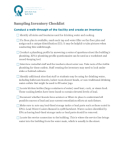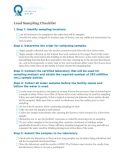
Eligible schools and childcare facilities can apply for funding to test their drinking water for lead. Public schools, charter schools, Head Start programs, and licensed childcare facilities are eligible to participate. Private schools are not eligible.
The funding process involves six steps:
1. Apply
Schools and childcare facilities can apply online. The application required the following information. Use this checklist to ensure that you have all the information gathered prior to applying.
- Name of school/school district/child care facility/head start program
- Mailing address (Street/P.O. Box, City, Zip Code)
- Contact person name, title, phone number, email
- Number of buildings to test (this should only include buildings where children spend time and consume water)
- Name(s) of building(s)
- Building’s physical address
- School district (Please include the school district your facility is physically located in, even if your facility isn’t a school)
- Year building was constructed
- Total number of children served by the schools
- Number of consumable taps in the building
- Walk through your building(s) and identify all the locations where children can drink water, such as a drinking fountain or a kitchen sink used to prepare food or baby formula
- Fixtures such as a bathroom sink or a sink in a maintenance closet would not be considered consumable points since children likely are not drinking water from those locations.
2. Sample
Each school or childcare facility will need to develop a sampling inventory. DDW has provided a template (20 KB) schools and childcare facilities can use to conduct their inventory and implement their sampling plan. Facilities are urged to follow the sampling protocol carefully for accurate results. More information can be found in the Environmental Protection Agency (EPA) 3Ts Toolkit for reducing lead in drinking water.
Create a Sampling Inventory
Conduct a walkthrough of the facility and create an inventory of all water sources used for drinking or cooking. Use the Sampling Inventory Checklist (927 KB) to develop the building inventory. It is best to be concise while also being as descriptive as possible when identifying fixture locations. For example, use “DF outside Rm 130” rather than just “Drinking Fountain.”
Collecting Samples
Once an inventory has been collected and sent to the division, the lab will ship the sample bottles to your school, as well as a lab sheet (409 KB). All samples should be collected before the facility opens and before the fixtures have been used (we recommend at least an 8 hour stagnation period). One 250-mL sample should be taken at each fixture. This is a first-draw sample, so it must be taken immediately after opening the faucet or valve. The final step will be to make sure the sample ID is marked on the bottle as well as the lab sheet, along with the date, time, and initials of the individual who collected the sample.
3. Interpret Results
If a sample exceeds a concentration of 15 parts per billion (ppb), the facility should remove the fixture from service. The fixture should remain out of service until steps have been taken to lower the concentration and a follow-up sample has confirmed that the concentration has fallen below action levels. DDW will work with participants to determine the best course of action to address elevated lead concentration from fixtures.
Money from this grant can be used to pay for follow-up samples and associated rush fees to have analysis expedited, but it cannot be used for remediation such as replacing fixtures, plumbing materials, or labor for remediation work.
4. Address Issues
Elevated lead concentrations may be temporarily lowered through routine flushing (332 KB), until the fixture is replaced. Flushing, however, may not suffice for some fixtures, which may need to be immediately taken out of service. A typical strategy would be to take a fixture out of service and take a flush sample. If flushing adequately reduces the concentration, the facility could implement a routine flushing schedule.
Schools and childcare facilities can explore a variety of additional options (864 KB) to reduce lead levels and remediate the problem.
- Implement a water usage plan to safeguard against lead exposure. This program may include flushing faucets at sinks and/or water fountains and limiting water consumption for food and beverage preparation to cold-water faucets.
- Replace faucets or other drinking water outlets found to be above the action level for lead. Ensure the use of “lead-free” materials, including lead-free solders.
- Physically disconnect faucets or plumbing with high levels of lead.
- Replace lead pipes on school or childcare property.
- Reconfigure plumbing to bypass sources of lead contamination.
- Install a water-treatment system.
- Provide bottled water.
5. Share Results
All sampling results will be submitted to DDW by the certified laboratory. The facility must make results available to the public and notify parents, teachers, and employee organizations of the availability of results no later than 90 days from when the results are received. Results will also be available on DDW’s WaterLink database.


